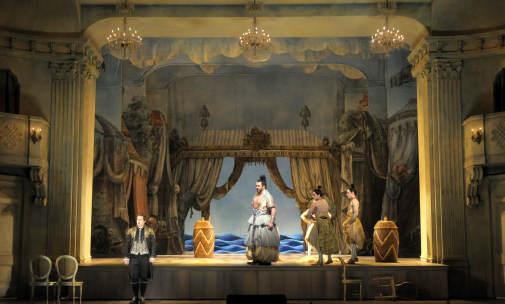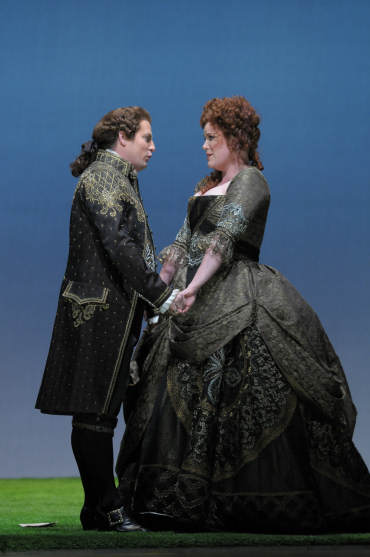Other Links
Editorial Board
-
Editor - Bill Kenny
-
Deputy Editor - Bob Briggs
Founder - Len Mullenger
Google Site Search
SEEN AND HEARD
INTERNATIONAL OPERA REVIEW
Mozart, Die Entführung aus dem Serail (“The Abduction from the Seraglio”): Soloists, Chorus and Orchestra of Lyric Opera of Chicago, Sir Andrew Davis (conductor) Civic Opera House, Chicago 7.3.2009 (JLZ)
In a new production by David Zinn, Lyric Opera of
Chicago has successfully returned Wolfgang Mozart’s
1782 Singspiel, Die Entführung aus dem Serail to
its stage. With a strong cast and effective
presentation, this production balances the dramatic, musical, and thematic
elements of this important early work very well. The
cast itself is finely balanced, with singers with international reputations. As
Belmonte, Michael Polenzani has given thoughtful shading to his character’s
sometimes challenging part. His supple tone is
entirely appropriate to the style of the work, and his phrasing gives shape to
Belmonte’s lines, not only in the solo numbers early in the work, but also
in the ensembles that are important to the scenes
bringing the story to its moving dénouement. In
giving voice to the passion which Belmonte expresses in his opening aria “Hier
soll ich dich denn sehen” through to the
Vaudeville-Finale, Polenzani’s clear and even sound makes his character come to
life vividly.
Likewise, Erin Wall’s depiction of Konstanze is both musically and dramatically
compelling. Her phrasing allowed her to bring out the
necessary subtleties that can often be
very challenging. Her opening aria “Ach, ich liebte”
was moving, and more impressive still was her balance
of passion and clarity in the famous second-act “Martern aller arten.”
Early on Wall demonstrated
her character's struggle
between faithfulness to the still-absent Belmonte and the overtures of the
surprisingly open-minded Pasha Selim. True to her heart, Konstanze puts aside
any exigencies in “Martern aller arten,” a decision that is rewarded by
Belmonte’s return shortly afterwards. Wall brought to
the stage an intelligent, refined, and persuasive performance
throughout the work.
Cast:
Belmonte: Matthew Polenzani
Osmin: Andrea Silvestrelli
Pedrillo: Steve Davislim
Selim: David Steiger
Konstanze: Erin Wall
Blonde: Aleksandra Kurzak
Production:
Stage Director: Chas Rader-Shieber
Stage, Set and Costume Design: David Zinn
Lighting: Christopher Akerlind
Chorus Master - Donald Nally
Conductor: Sir Andrew Davis

The Act I Set

Matthew Polenzani (Belmonte) and Erin Wall (Konstanze)
As Osmin, Andrea Silvestrelli embodied
the stereotypical threat ofcaptivity in
Kurzak was impressive for her ability to match
Silvestrelli phrase for phrase in that number, which followed quickly after her
engaging interpretation of “Durch Zärtlichkeit und Schmeicheln.” As
familiar as this is to regular
opera audiences, Kurzak’s fluid delivery was full of
facility and charm in her debut performance with Lyric Opera of
Chicago.
To complement the principals, Steve Davislim was equally strong as Pedrillo both
in his own physical characterization and
in vocal delivery. A tenor who has also sung the role
of Belmonte, it seems that such experience informed his performance here, allowing
him to work well with Polenzani and the other
principals. Davislim’s moved around the stage easily
as he bounded up and down the set, in giving
both energy and life to Pedrillo. His vocal
ability was apparent throughout and
his energetic second-act aria “Frisch zum Kampfe” was
particularly notable.
All in all, the soloists brought their best to their roles and work worked well
as an ensemble within the boundaries of this new
production of a familiar opera. A collaboration
between Lyric Opera of Chicago and San Francisco Opera, the production itself is
noteworthy for the focus it contributes. The first act opens
on a model of a traditional-looking, eighteenth-century stage, which
stands in front of a colorful scrim representing the
harem. Belmonte faces the stage, when he enters,
separating himself from the
world of the harem, the domain controlled by Osmin and his minions,
which also remains inaccessible to the audience. The
harem's separation from the outside world is shown more clearly still by
the fact even the Pasha’s people stand outside
of it at the end of the act: each of them costumed alike,
and all of them with long
moustaches, even the women in the chorus.
For the second act, the audience gets a glimpse of the harem from the
inside, from the perspective of Konstanze and Blonde,
whose enclosed world touches only
on the garden outside, to which Pedrillo
of course has access. In this act, though, a large
door is prominent at the center of the stage, and
apparently stands in front of the garden. That door is almost all that remains
in the third act. Through its use, this simple design
element grows in importance to
represent the boundary between the confinement of the harem in the
Pasha’s court and the free world which the Europeans see
as their goal. This movement from the more detailed
first act set to more abstract scenery for the end of
the opera serves the work well by allowing the
audience to focus on the music. After all, the music itself
has moved on from solo numbers to duets and,
ultimately to the quartet “Ach, Belmonte” which ends
Act II. This design
- quite properly - draws attention back to the performers whose
interactions are key to the drama's resolution.
At the same time, some carefully
chosen set details do contribute to the overall
effect. Belmonte’s gazing on Konstanze's image in the
first scene evokes the opening of the later
Die Zauberflote. Similarly, the presence of three women in burkas,
standing off to the side of the stage during Belmonte’s “O wie ängstlich”
suggest the three women in the same work. Musically
though, the intense
exchanges between the four principals, Konstanze, Blonde, Belmonte, and
Pedrillo, at the end of Act
II also called to mind some elements of Così fan tutte, if only
momentarily. Such details made
the production memorable and in
fact, the entire work was set as if it were
being recalled by the Pasha later in his career;
the roses he picks up at the end of the overture are those
that Konstanze drops when she finally leaves with
Belmonte. Doubling the younger Pasha on stage,
a recurring image of an
older Pasha adds an autumnal perspective to this promising work of the young
Mozart.
Ultimately it is the Pasha's
generosity which brings the satisfactory resolution of Die
Entführung about leaving the audience with the
libretto's eternal message. Pleas for tolerance
and forgiveness are as timely today as they were in the late eighteenth century.
Impressively sung, the final chorus imprinted
this eternal moral firmly
on everyone present. This fine production continues through the month of
March, and is a satisfying conclusion to Lyric Opera's
2008-2009 season.
James L Zychowicz
Pictures ©
Dan Rest
Back
to Top
Cumulative Index Page
